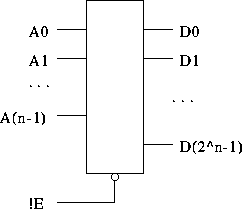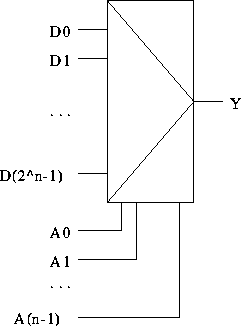Decoders, Encoders, and Muxes, Oh My!
Tom Kelliher, CS 220
Oct. 8, 2001
Bioinformatics talk tomorrow: Kelley @ 4:30. Refreshments @ 4:15.
Dinner afterwards, anyone?
Read 3.8--9.
Exam I.
- Decoders
- Encoders
- Muxes
Binary addition and subtraction.
Block diagram:

A circuit with n inputs. The inputs are interpreted as a binary number
and used to select one of  output lines.
output lines.
- Most common use: Address decoders for RAMs and register files.
- Decoder expansion example: design a 5-to-32 using 5 3-to-8 decoders.
- Example use: Design a BCD to seven segment decoder using a 4 to 16
decoder and OR gates.
Inverse of a decoder:  inputs; n outputs.
inputs; n outputs.
- What happens if multiple inputs are high?
- Most common uses: priority encoders for interrupt controllers;
``hit'' logic for caches.
- Design example: Four input priority encoder with a ``Valid'' output.
Used to select one of  inputs. One way switch.
inputs. One way switch.
Block diagram:

- Most common uses: RAM, register file data selection circuits; Boolean
function generators.
- What's a quad 2-1 mux?
- Design example: Implement a three input Boolean function using an 8-1
mux. No additional logic.
Four input Boolean function using an 8-1 mux and an inverter?
Five input Boolean function?
Thomas P. Kelliher
Sun Oct 7 17:33:56 EDT 2001
Tom Kelliher


 output lines.
output lines.
 inputs; n outputs.
inputs; n outputs.
 inputs. One way switch.
inputs. One way switch.
